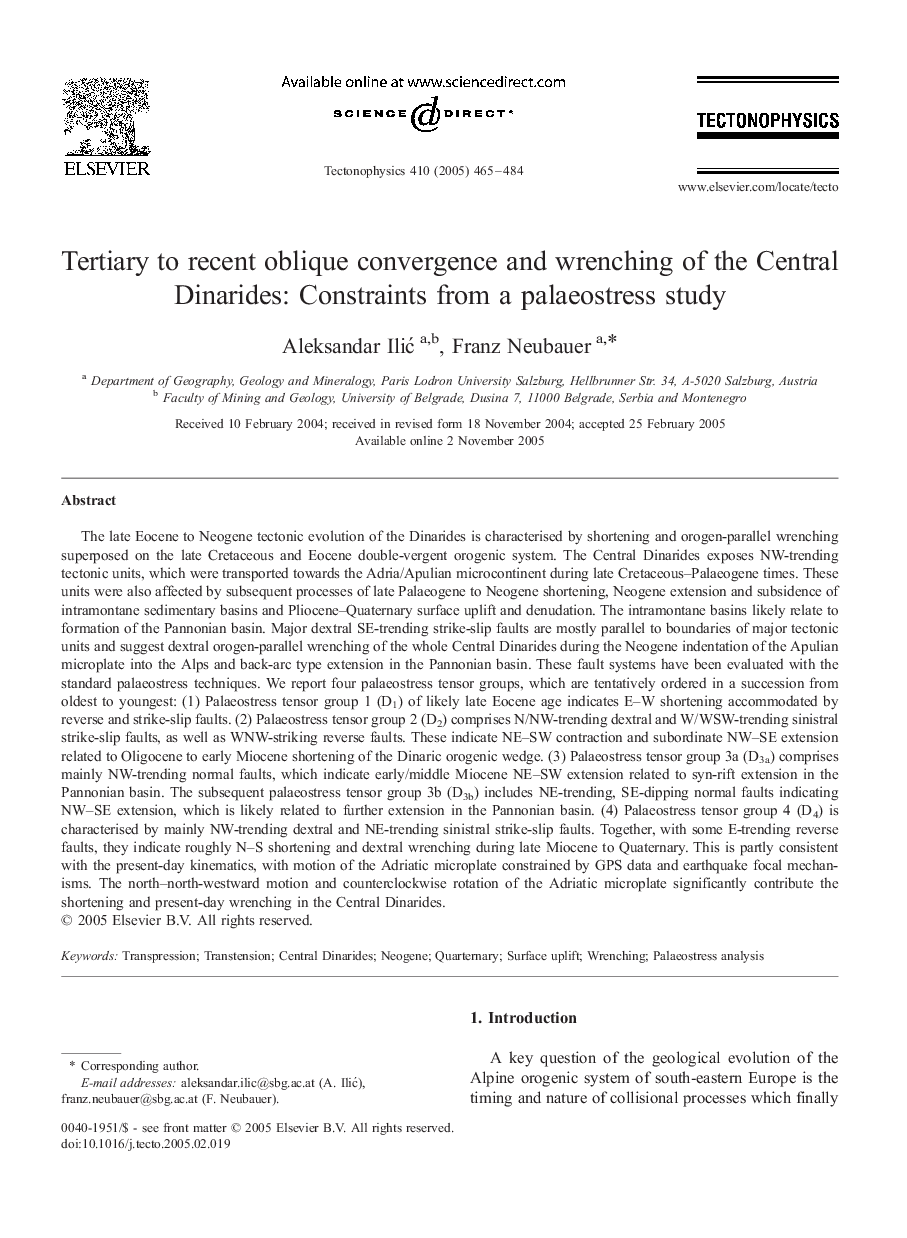| کد مقاله | کد نشریه | سال انتشار | مقاله انگلیسی | نسخه تمام متن |
|---|---|---|---|---|
| 9527009 | 1636968 | 2005 | 20 صفحه PDF | دانلود رایگان |
عنوان انگلیسی مقاله ISI
Tertiary to recent oblique convergence and wrenching of the Central Dinarides: Constraints from a palaeostress study
دانلود مقاله + سفارش ترجمه
دانلود مقاله ISI انگلیسی
رایگان برای ایرانیان
کلمات کلیدی
موضوعات مرتبط
مهندسی و علوم پایه
علوم زمین و سیارات
فرآیندهای سطح زمین
پیش نمایش صفحه اول مقاله

چکیده انگلیسی
The late Eocene to Neogene tectonic evolution of the Dinarides is characterised by shortening and orogen-parallel wrenching superposed on the late Cretaceous and Eocene double-vergent orogenic system. The Central Dinarides exposes NW-trending tectonic units, which were transported towards the Adria/Apulian microcontinent during late Cretaceous-Palaeogene times. These units were also affected by subsequent processes of late Palaeogene to Neogene shortening, Neogene extension and subsidence of intramontane sedimentary basins and Pliocene-Quaternary surface uplift and denudation. The intramontane basins likely relate to formation of the Pannonian basin. Major dextral SE-trending strike-slip faults are mostly parallel to boundaries of major tectonic units and suggest dextral orogen-parallel wrenching of the whole Central Dinarides during the Neogene indentation of the Apulian microplate into the Alps and back-arc type extension in the Pannonian basin. These fault systems have been evaluated with the standard palaeostress techniques. We report four palaeostress tensor groups, which are tentatively ordered in a succession from oldest to youngest: (1) Palaeostress tensor group 1 (D1) of likely late Eocene age indicates E-W shortening accommodated by reverse and strike-slip faults. (2) Palaeostress tensor group 2 (D2) comprises N/NW-trending dextral and W/WSW-trending sinistral strike-slip faults, as well as WNW-striking reverse faults. These indicate NE-SW contraction and subordinate NW-SE extension related to Oligocene to early Miocene shortening of the Dinaric orogenic wedge. (3) Palaeostress tensor group 3a (D3a) comprises mainly NW-trending normal faults, which indicate early/middle Miocene NE-SW extension related to syn-rift extension in the Pannonian basin. The subsequent palaeostress tensor group 3b (D3b) includes NE-trending, SE-dipping normal faults indicating NW-SE extension, which is likely related to further extension in the Pannonian basin. (4) Palaeostress tensor group 4 (D4) is characterised by mainly NW-trending dextral and NE-trending sinistral strike-slip faults. Together, with some E-trending reverse faults, they indicate roughly N-S shortening and dextral wrenching during late Miocene to Quaternary. This is partly consistent with the present-day kinematics, with motion of the Adriatic microplate constrained by GPS data and earthquake focal mechanisms. The north-north-westward motion and counterclockwise rotation of the Adriatic microplate significantly contribute the shortening and present-day wrenching in the Central Dinarides.
ناشر
Database: Elsevier - ScienceDirect (ساینس دایرکت)
Journal: Tectonophysics - Volume 410, Issues 1â4, 9 December 2005, Pages 465-484
Journal: Tectonophysics - Volume 410, Issues 1â4, 9 December 2005, Pages 465-484
نویسندگان
Aleksandar IliÄ, Franz Neubauer,